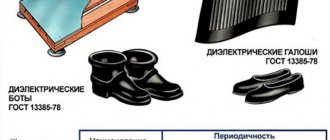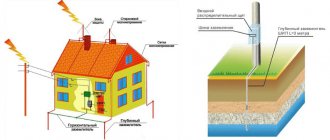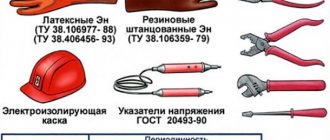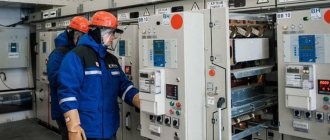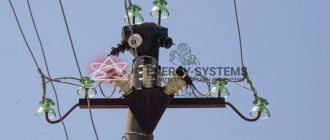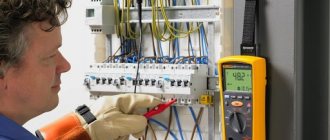| NAME OF WORKS | UNITS MEAS. | QTY | UNIT PRICE |
| Testing of dielectric rods of all types | steam. | 1 | RUB 245.00 |
Tel.
manager: +7 (495) 777-21-32 E-mail for ordering: [email protected]
Operative insulating rods are designed to solve operational problems during installation and repair of electrical installations. They are used for testing line connectors, measuring insulation, installing arresters and other parts in substations, power lines and various electrical installations. The rods consist of three elements - a handle, an insulating part and a working part.
To make the insulating part of portable grounding rods, special electrical insulating materials that are resistant to electric current are used. To check the quality characteristics of the tool, the laboratory of high-voltage electrical measurements of MOSENERGOTEST LLC conducts operational tests of insulating rods with the provision of protocols drawn up in accordance with all the rules.
Frequency of testing insulating rods
Operating portable grounding rods can be composite and contain several metal current-carrying links. It is allowed to use rods when working in electrical installations with voltages over 110 kV. The rods must have a design that provides a reliable detachable or permanent connection of portable grounding and current-carrying links with its subsequent fastening.
After receiving insulating rods from the warehouse or from the manufacturer, an increased voltage test must be carried out before using them, as well as during operation. The testing periods for insulating rods are established by regulatory documents and require their inspection 1-2 times a year.
Testing of insulating rods
We test operational insulating rods designed for operation in electrical installations with voltages from 1 kV to 110 kV with a linear voltage of at least 40 kV, and rods intended for operation in electrical installations with voltages over 110 kV - with a voltage equal to three times the phase operating voltage, but not less than 40 kV. During the tests, the test voltage is applied to a temporary electrode installed at the restrictive ring of the insulated part and to the working part of the tool. Testing time for operating rods is 5 minutes.
The stationary laboratory "MOSENERGOTEST" carries out testing of operational insulating rods for work on electrical installations up to 1000 V and more. Tests are carried out as quickly as possible; based on the test results, you receive an inspection report signed by the responsible persons.
We carry out high-quality testing of personal protective equipment and tools for working with high-voltage equipment. The check meets all the requirements of regulatory documents, current norms and rules. Before testing, the dielectric rod is carefully inspected. If there are defects, they are considered unusable and removed from testing. If the external inspection gives a positive result, the electrical and mechanical characteristics of the products presented to us are checked. We carry out testing in a laboratory equipped with the latest technology.
ELECTROlaboratory
Good day, dear friends!
Today I will dwell in more detail on insulating rods, because... questions still arise.
So, insulating rods are electrical protective equipment.
Insulating rods are among the main protective equipment both in installations up to 1000V and in installations above 1000V.
PURPOSE AND DESIGN.
Insulating rods are designed for operational work (operations with disconnectors, changing fuses, installing parts of arresters, etc.), measurements (checking insulation on power lines and substations), for applying portable grounding, as well as for releasing the victim from electric current.
General technical requirements for operational insulating rods and portable grounding rods are given in the state standard GOST 20494. Operating insulating rods and portable grounding rods. General technical conditions.
The rods should consist of three main parts: working, insulating and handle.
Rods can be composed of several links. To connect the links to each other, parts made of metal or insulating material can be used. It is permissible to use a telescopic structure, but reliable fixation of the links at their joints must be ensured.
The rod handle can be one piece with the insulating part or be a separate link.
The insulating part of the rods must be made of electrical insulating materials that do not absorb moisture, with stable dielectric and mechanical properties.
The surfaces of the insulating parts must be smooth, without cracks, delaminations or scratches.
The use of paper-bakelite tubes for the manufacture of insulating parts is not allowed.
Operating rods can have replaceable heads (working parts) to perform various operations. At the same time, their reliable fastening must be ensured.
The design of portable grounding rods must ensure their reliable detachable or permanent connection with grounding clamps, installation of these clamps on live parts of electrical installations and their subsequent fastening, as well as removal from live parts.
Composite portable grounding rods for electrical installations with voltages of 110 kV and higher, as well as for applying portable grounding to overhead line wires without lifting them to supports, may contain metal current-carrying links if there is an insulating part with a handle.
For intermediate supports of overhead power lines with a voltage of 500-1150 kV, the grounding structure may contain, instead of a rod, an insulating flexible element, which should be made, as a rule, of synthetic materials (polypropylene, nylon, etc.).
The design and weight of operational, measuring and relief rods for releasing a victim from electric current at voltages up to 330 kV must ensure that one person can work with them, and the same rods for voltages of 500 kV and higher can be designed for two people using a support device. In this case, the maximum force on one hand (supporting it at the restrictive ring) should not exceed 160 N.
The design of portable grounding rods for applying to overhead lines with a person lifting to a support or from telescopic towers and in switchgear with voltages up to 330 kV should ensure that one person can work with them, and portable grounding rods for electrical installations with voltages of 500 kV and higher, as well as for applying grounding to overhead line wires without lifting a person to a support (from the ground) can be designed for work by two people using a supporting device. The greatest force on one hand in these cases is regulated by technical conditions.
The main dimensions of the rods must be no less than those indicated in the following tables:
Performance tests
During operation, mechanical tests of rods are not carried out.
High-voltage electrical tests of insulating parts of operational and measuring rods, as well as rods used in testing laboratories for supplying high voltage, are carried out in accordance with the following requirements:
Acceptance, periodic and type tests are carried out at the manufacturer according to the standards and methods set out in the relevant standards or technical specifications.
In operation, protective equipment is subjected to regular and extraordinary operational tests (after a fall, repair, replacement of any parts, if there are signs of malfunction).
Tests are carried out according to approved methods (instructions).
Mechanical tests are carried out before electrical tests.
All testing of protective equipment must be carried out by specially trained and certified personnel.
Before testing, each protective equipment must be carefully inspected to check the presence of manufacturer's markings, numbers, completeness, absence of mechanical damage, and the condition of insulating surfaces (for insulating protective equipment). If the protective equipment does not meet the requirements
INSTRUCTIONS
FOR USE AND TESTING OF PROTECTION MEANS USED IN ELECTRICAL INSTALLATIONS ( SO 153-34.03.603-2003)
Tests are not carried out until the identified deficiencies are eliminated.
Electrical tests should be carried out with alternating current of industrial frequency, as a rule, at a temperature of plus (25±15) °C.
Electrical testing of insulating rods should begin with checking the electrical strength of the insulation.
The rate at which the voltage rises to 1/3 of the test voltage can be arbitrary (a voltage equal to the specified voltage can be applied by a push), a further increase in voltage should be smooth and fast, but allowing the readings of the measuring device to be read at a voltage of more than 3/4 of the test voltage. After reaching the rated value and holding at this value for a rated time, the voltage must be smoothly and quickly reduced to zero or to a value not exceeding 1/3 of the test voltage, after which the voltage is turned off.
The test voltage is applied to the insulating part of the protective equipment. In the absence of an appropriate voltage source for testing entire insulating rods, it is allowed to test them in parts. In this case, the insulating part is divided into sections to which a part of the normalized full test voltage is applied, proportional to the length of the section and increased by 20%.
Basic insulating electrical protective equipment intended for electrical installations with voltages above 1 to 35 kV inclusive are tested with a voltage equal to 3 times the linear voltage, but not lower than 40 kV, and those intended for electrical installations with voltages of 110 kV and above - equal to 3 times the phase voltage.
The duration of application of the full test voltage is usually 1 min. for insulating protective equipment up to 1000 V and for insulation made of elastic materials and porcelain and 5 min. — for insulation from layered dielectrics.
For specific protective equipment and working parts, the duration of application of the test voltage is given in the Appendices 5
And
7
.
Breakdown, flashover, and surface discharges are determined by turning off the testing facility during testing, by readings from measuring instruments, and visually.
Electrical protective equipment made of solid materials should be checked by touch immediately after testing for the absence of local heating due to dielectric losses.
If a breakdown, flashover or surface discharge occurs, the current through the product increases above the rated value, or local heating occurs, the protective equipment is rejected.
In this case, voltage is applied between the working part and a temporary electrode placed at the restrictive ring on the side of the insulating part.
The heads of measuring rods for monitoring insulators in electrical installations with voltages of 35-500 kV are also tested.
Portable grounding rods with metal links for overhead lines are tested according to the method of clause 2.2.13 of the Instructions...
Testing of other portable grounding rods is not carried out.
An insulating flexible grounding element of a rodless design is tested in parts. For each 1 m section, a portion of the total test voltage is applied, proportional to the length and increased by 20%. It is allowed to simultaneously test all sections of an insulating flexible element wound into a coil so that the length of the semicircle is 1 m.
The standards and frequency of electrical testing of rods and insulating flexible grounding elements of rodless design are as follows:
.
Terms of use
Before starting to work with rods that have a removable working part, you need to make sure that the threaded connection of the working and insulating parts does not “jam” by screwing and unscrewing them once.
Measuring rods are not grounded during operation, except in cases where the principle of the rod design requires its grounding.
When working with an insulating rod, you should climb onto a structure or telescopic tower, as well as descend from it, without a rod.
In electrical installations with voltages above 1000 V, insulating rods should be used with dielectric gloves.
The operating rod SHO-1 up to 1000 V looks like this:
Operating rod SHO-10 up to 10 kV
Universal operational rod SHOU-10:
When the handle is rotated, the clamp of the working part is compressed or unclenched, which is used to replace safety inserts.
The portable grounding rod looks like this:
There may be not three, but one rod that is connected to each clamp in turn.
How do you know if a rod is suitable for use or not?
According to the stamp applied to the rod in the area of the handle after regular electrical tests of the following form:
№ _______
Suitable up to _____ kV
Next test date “____” __________________ 20___
_________________________________________________________________________
(laboratory name)
Where the factory or inventory number of the rod is indicated, the upper voltage limit at which operation of the rod is allowed, the date of the next test (if the date is expired, then operation of the rod is unacceptable), the name of the ETL that tested the rod.
As for storing the rods, they should be stored in a specially designated place, suspended, positioned perpendicular to the ground, avoiding the creation of mechanical stress in them, in order to avoid deformation or breakage.
That's all for me.
I wish you success.
